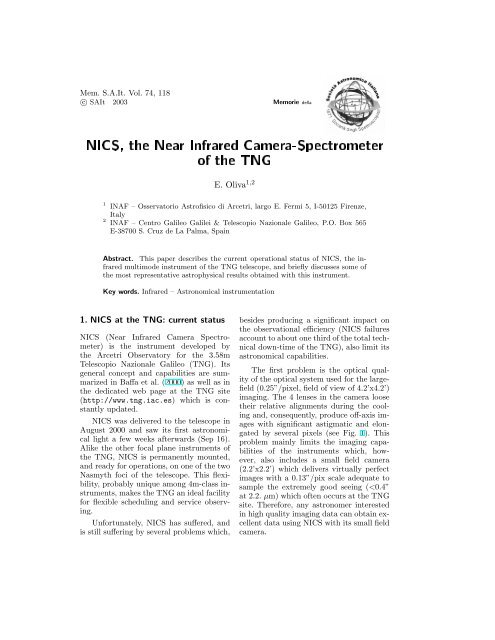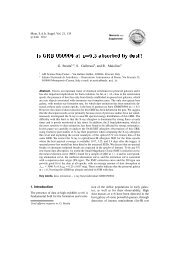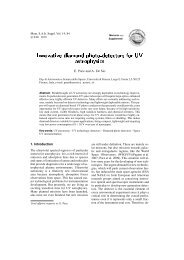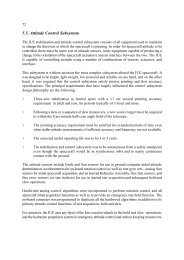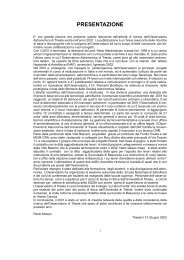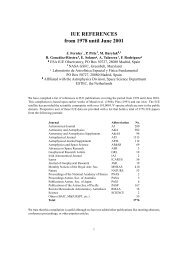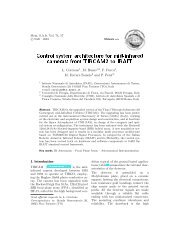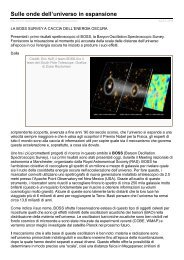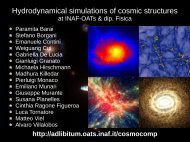NICS, the Near Infrared Camera-Spectrometer of the TNG
NICS, the Near Infrared Camera-Spectrometer of the TNG
NICS, the Near Infrared Camera-Spectrometer of the TNG
Create successful ePaper yourself
Turn your PDF publications into a flip-book with our unique Google optimized e-Paper software.
E. Oliva: <strong>NICS</strong> – <strong>TNG</strong> 119Fig. 1. <strong>NICS</strong> image <strong>of</strong> a pin-hole mask showing <strong>the</strong> optical abberations, particularlyevident in <strong>the</strong> top corners. Similar images toge<strong>the</strong>r with updated information on <strong>the</strong>status <strong>of</strong> <strong>the</strong> optics can be found at <strong>the</strong> <strong>TNG</strong> dedicated web page.The second problem is related to <strong>the</strong>controller <strong>of</strong> <strong>the</strong> detector and low level electronicswhich, besides producing significantoverheads for observations with short on–chip integration times (e.g. imaging observationsin H and K), are sometimes unstableand force <strong>the</strong> observer to abort <strong>the</strong> exposureand manually reset <strong>the</strong> system severaltimes during <strong>the</strong> night. This problemshould be cured relatively soon, once <strong>the</strong>new low-level electronics and detector controlsystem will be operative.Always related to <strong>the</strong> detector and/orlow levels electronics is <strong>the</strong> awkward behaviour<strong>of</strong> one <strong>of</strong> <strong>the</strong> four quadrants <strong>of</strong><strong>the</strong> array which sometimes becomes unstableand produce virtually useless data (see
120 E. Oliva: <strong>NICS</strong> – <strong>TNG</strong>Fig. 2. Example <strong>of</strong> <strong>the</strong> effects produced by <strong>the</strong> instability <strong>of</strong> <strong>the</strong> first (bottom left)quadrant which produces a large <strong>of</strong>fset and extra-noise in <strong>the</strong> images. This unpredictable,and so far not understood effect usually disappears after 10–30 minutes but, in some cases,may persist for several hours. The image displayed here is <strong>the</strong> difference between two300 sec exposures with <strong>the</strong> instrument set in spectropolarimetric mode with <strong>the</strong> Amicidisperser and <strong>the</strong> 0.5” slit. The four pairs <strong>of</strong> stellar traces correspond, from bottom totop, to measurements taken through a 90 o , 0 o , 45 o and 135 o ideal polarizer, respectively;wavelength increases from right to left. In this particular case <strong>the</strong> problem with <strong>the</strong> firstquadrant limited <strong>the</strong> accuracy <strong>of</strong> <strong>the</strong> polarimetric measurements in <strong>the</strong> K band. Thedata were collected on Feb 6, 2002 and <strong>the</strong> targetted object was SN2002ap which was“di<strong>the</strong>red” along <strong>the</strong> slit to achieve an accurate sky-subtraction. The reduced spectra arepublicly avalable at <strong>the</strong> <strong>TNG</strong> web site.Fig. 2), <strong>the</strong> origin <strong>of</strong> this problem is stillunclear.The last problem is related to <strong>the</strong> mechanics,in particular to <strong>the</strong> fragility <strong>of</strong> <strong>the</strong>gears and to <strong>the</strong> positioning <strong>of</strong> <strong>the</strong> slit andgrism wheels which <strong>of</strong>ten loose step andleave <strong>the</strong> selected slit/grism in an incorrect,tilted position thus forcing <strong>the</strong> observerto reset <strong>the</strong> wheel and repeat <strong>the</strong> operation.Considered that similar problemson <strong>the</strong> camera wheel have been solved during2001, <strong>the</strong>re are good reasons to expectthat <strong>the</strong>se defects will be eliminated.
Table 1. Imaging background (1) and sensitivitiesE. Oliva: <strong>NICS</strong> – <strong>TNG</strong> 121Filter Typical background Limiting sensitivity(mag/sq. arcsec) (1h, 5σ, 1” seeing)J 15.6 21.9H 14.0 21.2K’ 13.4 20.7K 12.8 20.3(1) Please note that <strong>the</strong> values for J, H are somewhat conservative. The actual background in<strong>the</strong>se bands is dominated by airglow emission and may vary by more than 1 magnitudeduring a single night, an instructive example is given in Fig. 3.Going to <strong>the</strong> positive notes, it is importantto note that <strong>the</strong> sky backgrounds measuredwith <strong>NICS</strong> in K’ and K are among <strong>the</strong>lowest in <strong>the</strong> world (see Table 1 and Fig. 3),in spite <strong>of</strong> <strong>the</strong> fact that <strong>the</strong> <strong>TNG</strong> is notan IR optimized telescope. This remarkableresult, which makes <strong>NICS</strong> ≃0.5 mag moresensitive in K than e.g. its direct competitoron <strong>the</strong> WHT (INGRID), is <strong>the</strong> consequence<strong>of</strong> <strong>the</strong> careful optical design whichforesees a very accurate re-imaging <strong>of</strong> <strong>the</strong>pupil which is blocked by a Lyot stop, seeOliva & Gennari (1995) for details.Never<strong>the</strong>less, <strong>the</strong> strongest and mostpopular feature <strong>of</strong> <strong>NICS</strong> is represented byits spectroscopic modes which are summarizedin Fig. 4. Besides <strong>the</strong> very widechoice <strong>of</strong> “classical” grisms, which allowmedium resolution spectroscopic observations,<strong>NICS</strong> <strong>of</strong>fers an Amici prism disperserwhich delivers complete 0.9-2.5 µm lowresolution spectra with un-precedent efficiency(see also Oliva (2000)). This featureis unique among astronomical IR instrumentsand, most important, allows takingcomplete spectra <strong>of</strong> faint astronomical withintegration times and sensitivities comparableto, or even better than those achievablewith <strong>the</strong> IR instruments now availableon 8m class telescopes.2. Scientific highlightsSo far, <strong>the</strong> most remarkable results were obtainedwith <strong>the</strong> very low resolution spectroscopicmode. These demonstrate that, byproperly designing and optimizing an instrument,it is possible to fully exploit amedium size telescope like <strong>the</strong> <strong>TNG</strong>.2.1. Spectroscopy <strong>of</strong> Trans-neptunianobjectsTrans neptunian objects (TNOs) are largeasteroids orbiting beyond Neptune whichare believed to be <strong>the</strong> most pristine objects<strong>of</strong> <strong>the</strong> solar system. For this reason <strong>the</strong>yhave recently became very popular and, undera certain point <strong>of</strong> view, helped to revive<strong>the</strong> general interest in solar system astronomy.Being so distant, TNOs are faint objectswith, typically, J>18 and, <strong>the</strong>refore,difficult to study spectroscopically in <strong>the</strong>IR even with 10m-class instruments. The“status <strong>of</strong> art” in this field is well representedby <strong>the</strong> right-hand panel <strong>of</strong> Fig. 5which displays a collection <strong>of</strong> IR spectrataken with <strong>the</strong> Keck (adapted fromBrown et al. (2000)). The comparison with<strong>the</strong> <strong>NICS</strong>-Amici spectra <strong>of</strong> Licandro etal. ((2001)) shown in <strong>the</strong> left-hand panel<strong>of</strong> Fig. 5 is striking. Apart for coveringa much broader wavelength range (whichcan only be achieved with a prism disperser),<strong>the</strong> <strong>NICS</strong>-<strong>TNG</strong> spectra have s/nratios comparable to or even better than<strong>the</strong> Keck’s data. Note in particular <strong>the</strong> case<strong>of</strong> 2000 EB173, which appeared flattish andfeatureless in <strong>the</strong> Keck spectrum. On <strong>the</strong>
122 E. Oliva: <strong>NICS</strong> – <strong>TNG</strong>Fig. 3. Variation <strong>of</strong> <strong>the</strong> sky brightness during a typical observing night. The values in<strong>the</strong> various bands are simultaneous and are derived from 98 spectra taken with <strong>the</strong>Amici disperser on Mar 5/6, 2002, a night <strong>of</strong> half–moon which, noticeably, rised at 02UT (i.e. <strong>the</strong> higher background values were measured when <strong>the</strong> sky was “dark”).contrary, <strong>the</strong> <strong>NICS</strong> spectrum demonstratedthat this object is very red and with adeep and broad absorption feature in <strong>the</strong>K–band. This type <strong>of</strong> spectrum indicatesthat <strong>the</strong> surface <strong>of</strong> this object underwentconsiderable processing by particle irradiation.2.2. Spectroscopy <strong>of</strong> brown dwarfsThe study <strong>of</strong> brown dwarfs, i.e. stars withvery low mass and unable to start nuclearreactions in <strong>the</strong>ir cores, has been one <strong>of</strong> <strong>the</strong>most productive and popular field <strong>of</strong> stellarresearch in <strong>the</strong> last years. These objectsare cold and extremely red and, in severalcases, virtually invisible at optical wavelengths.Thanks to <strong>the</strong> large IR surveys(2mass and Denis), a considerable numbers<strong>of</strong> <strong>the</strong>se stars have been discovered andclassified using a variety <strong>of</strong> methods.<strong>NICS</strong>-<strong>TNG</strong> gave a very important contributionto this field by making it possibleto obtain, with quite short integrationtimes, complete IR spectra with high accuracyon <strong>the</strong> overall spectral distribution.These data were used to define new indicesfor <strong>the</strong> classification <strong>of</strong> <strong>the</strong> stars (Testi etal. (2001)) as well as to study and classifycandidates <strong>of</strong> young and low mass objectsin star forming regions. Fig. 6 shows <strong>the</strong>spectrum <strong>of</strong> <strong>the</strong> most outstanding <strong>of</strong> such
124 E. Oliva: <strong>NICS</strong> – <strong>TNG</strong>2water iceRelative reflectance1.512000 WR1060.52000 EB1731 1.2 1.4 1.6 1.8 2 2.2 2.4Wavelength (microns)Fig. 5. Left panel: <strong>NICS</strong>-Amici spectra <strong>of</strong> two transneptunian objects <strong>of</strong> magnitudesJ≃18.5, <strong>the</strong> y-scale (“reflectance”) is <strong>the</strong> ratio between <strong>the</strong> object and <strong>the</strong> solar spectra.Both objects are very red between 0.9 and 1.8 µ and display a broad absorption deaturein <strong>the</strong> K band. The spectrum <strong>of</strong> 2000 WR106 has quite deep water ice absorption featuresat 1.5 and 2.0 microns (see <strong>the</strong> comparison spectrum <strong>of</strong> 10 microns water ice particles at90 K at <strong>the</strong> top <strong>of</strong> <strong>the</strong> figure).Right hand panel: collection <strong>of</strong> Trans-neptunian spectra taken with <strong>the</strong> Keck telescope.Fig. 6. <strong>NICS</strong>-Amici spectrum <strong>of</strong> a candidate brown dwarf in <strong>the</strong> ρ-Oph cloud comparedwith a <strong>the</strong>oretical spectrum (in red). The combination <strong>of</strong> extremely low mass (0.01 M ⊙ )and very young age (
E. Oliva: <strong>NICS</strong> – <strong>TNG</strong> 125Fig. 7. <strong>NICS</strong>-Amici spectrum <strong>of</strong> one <strong>of</strong> <strong>the</strong> most distant (z=5.80) Quasar known. Theobject has a J≃18 and was observed with <strong>NICS</strong>-Amici with a total integration time<strong>of</strong> about 1 hour during <strong>the</strong> first months <strong>of</strong> instrument commisioning. The comparisonbetween <strong>the</strong> observed spectrum (spectrum) and <strong>the</strong> average UV spectrum <strong>of</strong> nearbyquasars (red) indicates that this objects in not reddened and has a prominent CIVabsorption line.in particular to C. Baffa, A. Checcucci, G.Comoretto, S. Gennari, G. Marcucci, M. Sozziand P. Stefanini whose work and assistancewere, and still are, essential for <strong>the</strong> developmentand maintenance <strong>of</strong> <strong>the</strong> instrument.Infinite thanks also to those who organized thisnice conference and revived <strong>the</strong> tradition <strong>of</strong> assemblingtoge<strong>the</strong>r <strong>the</strong> Italian IR community.ReferencesBaffa C., Comoretto G., Gennari S., et al.,2001, A&A 378, 722Brown M.E., Blake G. A., Kessler J.E., ApJ543, L163Licandro J., Oliva E., Di Martino M., A&A373, L29Maiolino R., Mannucci F., Baffa C., GennariS., Oliva E., 2001, A&A 372, L5Oliva E., Gennari S., 1995, A&AS 114, 179Oliva E., 2000, Mem. Soc. Astr. It. 71, 861Testi L., D’Antona F., Ghinassi F., et al.,2001, ApJ 552, L150Testi L., Natta A., Oliva E., 2002, ApJLetters, in pressNote added in pro<strong>of</strong>: During <strong>the</strong> periodFebruary-March 2003, <strong>the</strong> Nasmyth-A focalstation underwent a series <strong>of</strong> major maintanenceworks which included re-aligning <strong>of</strong> <strong>the</strong>elevation and derotator encoder heads, upgrade<strong>of</strong> <strong>the</strong> derotator optics/mechanics andmaintenance <strong>of</strong> <strong>the</strong> adaptive optics module.Taking advantage <strong>of</strong> <strong>the</strong> relatively long period<strong>of</strong> inactivity for <strong>the</strong> Nasmyth-A instruments,<strong>the</strong> IR-group <strong>of</strong> <strong>the</strong> Arcetri Observatory hadenough time to study and eventually solvemost <strong>of</strong> <strong>the</strong> problems suffered by <strong>NICS</strong>. Theworks included major modifications to <strong>the</strong> mechanics,optics, electronics and led to an instrumentwith a much improved image quality, free<strong>of</strong> <strong>the</strong> electronic instabilities which affected one<strong>of</strong> <strong>the</strong> array’s quadrants, and with much moreprecise and reliable mechanical movements.


